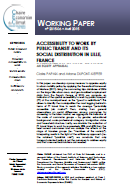
A new behavioral framework to analyze preference construction and decision processes within the modal choice
Par Hugo Bois
This paper discusses a new framework to explain the decision-making process of modal choice. A specific approach, based on the behavioral framework developed by Ben-Akiva & Boccara (1987), is adopted to understand and analyze the decision processes of individuals. Precisely, we use the Analytic Hierarchy Process (AHP) to build the hierarchy of preferences from attitudes and perceptions. Through the hierarchy of preferences, we can apply three different methods to better explain the decision processes; namely a standard compensatory model, a non-compensatory model based on the decision rules, and different possible weightings of the AHP method. The random utility maximization is predominantly used in the transportation literature because of its strong theoretical background, its success in predicting many types of human behavior, and the simplicity of mathematical and statistical analyses and model estimation it offers. Despite that, we believe that non-compensatory approaches are better suited to understand both travel behaviors and decision processes for transportation modes when taking active modes into account. These approaches allow us to better explain the impacts of each modal attribute on the one hand and to build psychological profiles with respect to decision rules on the other hand. Thus, it is possible to simulate shocks all things being equal.
